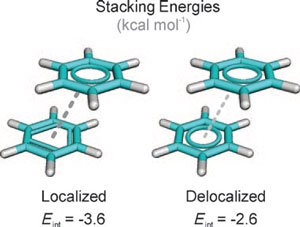Fa poc en Miquel Solà parlava en aquest blog de la hiperaromaticiat, un nou tipus d’aromaticitat, un concepte que s’entèn molt bé: es tracta d’una propietat que presenten alguns compostos cíclics orgànics i inorgànics amb dobles enllaços conjugats. La deslocalització electrònica present en aquests compostos els hi confereix una gran estabilitat.
Ara el web Chemistry World, de la Royal Society of Chemistry, publica una entrada interessant titulada Pi-stacking better without the aromatics?sobre uns resultats una mica xocants, a partir de càlculs computacionals. Es tracta que que les energies d’interacció entre dos anells conjugats aromàtics poden ser inferiors a les energies d’interacció entre un anell aromàtic i dobles enllaços poliènics, que no tenen aromaticitat:

Scientists in the US have discovered that electrons confined to their double bonds can sometimes deliver stronger pi-stacking interactions than those roaming free in aromatic systems. The discovery could have a big impact on the design of receptors and supramolecular assemblies that rely on delocalised systems, they say.
Pi-stacking interactions are usually thought of as occurring between aromatic rings, and such interactions along with anion-pi and cation-pi interactions are often collectively referred to as ‘aromatic interactions’.
Fins i tot el Chemistry World gosa dir que el concepte d'”interaccions aromàtiques” no és gaire adient:
Now, Steven Wheeler and colleagues at Texas A&M University have shown, using computational chemistry, that the monomer aromaticity is not necessary in aromatic interactions, and it can even hinder aromatic interactions in some cases. ‘The term “aromatic interactions” is really a misnomer,’ says Wheeler ‘Or at least it implies too strict a definition of these interactions.’
L’expert en aromaticitat Paul v.R. Schleyer diu que l’article de Wheeler és un pas molt important per a la comprensió de les interaccions d’aquest tipus. I molt important, el mateix Wheeler recorda la importància de comprovar les prediccions teòriques de forma empírica:
Even though this is a theoretical study, Wheeler explains that many research groups have devised ways of measuring stacking free energies experimentally. ‘These molecular probes are typically used to measure the effect of substituent or heteroatoms on pi-stacking interactions,’ he says. ‘I think that some of these probes could be adapted to directly measure the stacking free energy of two phenyl rings versus a phenyl ring and a non-aromatic cyclic polyene.’
on proposa mesurar l’energia lliure de pi-stacking entre (a) dos anells fenil i (b) un anell fenil i un poliè cíclic no aromàtic, i evidentment comparar-les per veure si, com prediuen els càlculs teòrics, és superior en el segon cas.
Donat que a l’Institut de Química Computacional de la UdG hi ha una important línia de recerca sobre aromaticitat, aquest article segur que proporciona noves pistes i senyala un important camí de cara a futura recerca.
Referència: J W G Bloom and S E Wheeler, Angew. Chem., Int. Ed., 2011, DOI: 10.1002/anie.201102982